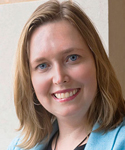David Ruth
713-348-6327
david@rice.edu
Amy Hodges
713-348-6777
amy.hodges@rice.edu
Religious, nonreligious organizations may have similar impact on ability of immigrants to acclimate to life in US
HOUSTON – (April 8, 2013) – Religious and nonreligious organizations may have a similar impact on the ability of immigrants to acclimate to life in the U.S., despite the organizations’ different motivations for providing charitable services, according to new research from Rice University.
 “There’s been a lot of discussion as to whether religious organizations offer some special or unique benefit to immigrant groups that will help them better adapt to American society,” said the study’s lead author, Elaine Howard Ecklund, the Herbert S. Autrey Professor of Sociology and director of Rice’s Religion and Public Life Program. “We wanted to see at the organizational level whether there was any practical difference between these two groups.”
“There’s been a lot of discussion as to whether religious organizations offer some special or unique benefit to immigrant groups that will help them better adapt to American society,” said the study’s lead author, Elaine Howard Ecklund, the Herbert S. Autrey Professor of Sociology and director of Rice’s Religion and Public Life Program. “We wanted to see at the organizational level whether there was any practical difference between these two groups.”
The study examined the behavior of two Mexican-American organizations, one religious and one nonreligious. The two groups identified different motivations for providing job placement, language and financial services to immigrants: The religious organization said its religious convictions necessitated service to the local community, whereas the nonreligious organization cited its commitment to at-risk groups. However, the study showed that there was was little difference in the impact of the two organizations – both sought to provide outreach and services to their respective communities.
The study’s co-author, Michael Emerson, the Allyn and Gladys Cline Professor of Sociology and Kinder Institute co-director, noted that although there is little difference between the organizations at the present time, that may change in the future.
“There may be significant changes as these organizations deal with second- and third-generation Mexican-Americans,” Emerson said. “These individuals might have different concerns, so the mission and services provided by these organizations very well may change.”
Ecklund said that given the significant impact of Latin Americans in the U.S. and within the Catholic Church, Latinos are an excellent case for assessing the connection between religion and civic engagement for new U.S. immigrants.
“The Latino population of the U.S. has grown at a substantial rate, and census data projects that Latinos will comprise 30 percent of the U.S. population by the year 2050,” Ecklund said. “And Latin Americans are changing the face of the Catholic Church: For the first time ever, the church has a pope from this region. And the impact of Latin Americans – especially Mexican-Americans – on the Catholic Church is more profound than that of any other ethnic group on a religious organization in the U.S.”
“Such a large and growing population group has the potential to dramatically impact American religious and civic life in the near future,” Emerson said. “It really behooves us to know more about how Mexican-Americans operate within these organizations.”
The study involved two organizations – a Mexican Catholic church and a nonreligious Mexican ethnic organization located in a large city in the southwestern United States. Both organizations had a similar location and resources and provided various services to immigrants, including job placement, language classes and assistance with navigating fiscal issues and the Internal Revenue Service. Data on both organizations was collected through personal interviews with members and leaders involved in each organization (a total of 16) and a year of participant observation in each organization.
The interviews varied in length from 20 minutes to almost two hours and included questions about the organization’s vision and mission, messaging, social and racial makeup and organizational challenges. The participant observations in the religious organization included religious services, the Spanish young adult group and the job assistance program, among other events. Observations in the ethnic organization included events such as adult literacy classes, a tour of the facilities and a young-adult conference hosted by the organization.
The article, “Motivating Civic Engagement: In-Group Versus Out-Group Service Orientations Among Mexican-Americans in Religious and Nonreligious Organizations,” was co-authored by Rice alumni Celina Davis and Samuel Kye, who is a graduate student at Indiana University, and Esther Chan, a postbaccalaureate fellow in sociology at Rice.
The study was funded by a grant from the Russell Sage Foundation and will appear in an upcoming edition of Sociology of Religion. It is available online at http://bit.ly/YZulBL.
-30-
For more information, contact David Ruth, director of national media relations at Rice, at 713-348-6327 or david@rice.edu.
This news release can be found online at https://news2.rice.edu/.
Follow Rice News and Media Relations via Twitter @RiceUNews.
Related Materials:
Rice University Department of Sociology: http://sociology.rice.edu/
Elaine Howard Ecklund bio: http://sociology.rice.edu/Content.aspx?id=117.
Elaine Howard Ecklund headshot (Credit: Rice University): https://news2.rice.edu/files/2012/10/1019_ECKLUND-mug.jpg
Michael Emerson bio: http://sociology.rice.edu/Content.aspx?id=110
Michael Emerson headshot (Credit: Rice University): https://news2.rice.edu/files/2013/04/0928_Emerson.jpg.
Located on a 300-acre forested campus in Houston, Rice University is consistently ranked among the nation’s top 20 universities by U.S. News & World Report. Rice has highly respected schools of Architecture, Business, Continuing Studies, Engineering, Humanities, Music, Natural Sciences and Social Sciences and is home to the Baker Institute for Public Policy. With 3,708 undergraduates and 2,374 graduate students, Rice’s undergraduate student-to-faculty ratio is 6-to-1. Its residential college system builds close-knit communities and lifelong friendships, just one reason why Rice has been ranked No. 1 for best quality of life multiple times by the Princeton Review and No. 2 for “best value” among private universities by Kiplinger’s Personal Finance. To read “What they’re saying about Rice,” go to http://tinyurl.com/AboutRiceU.
If you do not wish to receive news releases from Rice University, reply to this email and write “unsubscribe” in the subject line. Office of News and Media Relations – MS 300, Rice University, 6100 Main St., Houston, TX 77005




Leave a Reply